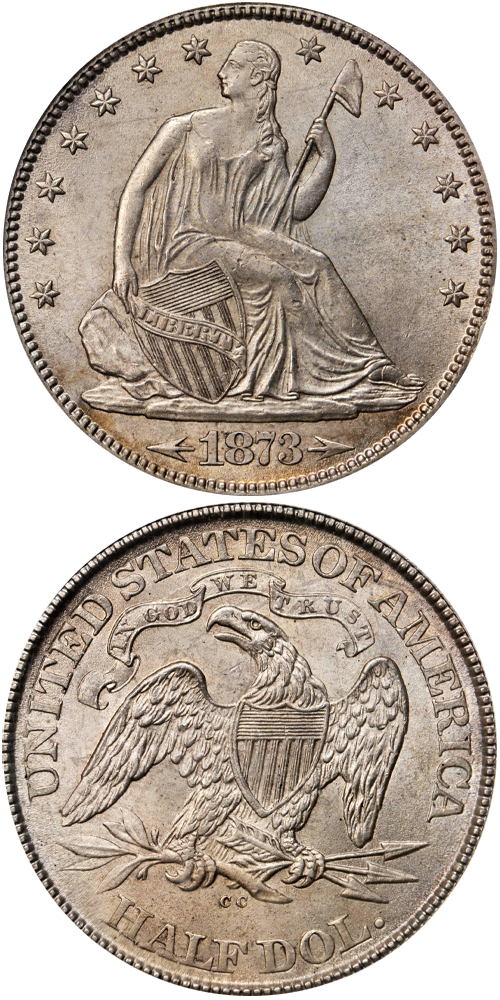1873-CC Liberty Seated Half Dollar
Arrows
Jeff Ambio: WB-5 is the rarest of the three die marriages for the 1873-CC Arrows half dollar, all sharing the same Small CC reverse. WB-5 is identifiable by a concentration of small die lumps within the drapery at Liberty's left (facing) forearm. Examples were struck after those of the WB-3 and WB-4 die marriages, as evidenced by the presence of an additional reverse die crack for WB-5 that meanders through the letters in the word HALF. Earlier die cracks are present through the olive leaves, through some of the letters in the word UNITED and along the tops of the letters ERICA in AMERICA.
Rusty Goe: Superintendent Henry F. Rice acknowledged receipt of the new dies for the Coinage Act-mandated half dollars, with arrows, to Carson City's local press on April 2, 1873.
A month later, in early May, the new, higher-weight planchets were delivered to Coiner Chauncey Noteware so he could stamp the first 14,000-piece run of 1873-CC Arrows half dollars.
After making his decision to resign as superintendent in protest of the government's act of firing Coiner Noteware and Melter-Refiner R.P. Andrews, Henry F. Rice spent May and June preparing to pass the key to the mint to Frank D. Hetrich.
On June 18, Coiner Noteware's replacement, William "Hy" Doane visited the mint so Noteware could give him a department orientation. Something happened that day that might provide clues as to how two 1873-CC Arrows half dollars, which have significant value as error coins today, were made.
Numismatists discovered one of these specimens years ago. Yet only after the second one was discovered by a summer intern at the Nevada State Museum in Carson City in 2008 was the first one identified as a "CC" coin.
The Carson Appeal reported in its June 19, 1873 edition: "Yesterday and the day before, the Coiner at the Mint was busily at work coining half dollar pieces, to the extent of several thousand dollars [6,000 pieces]. A breakage in some of the machinery used in the coining process suspended operations." The mint's machinist, George Fleming, immediately began to repair the equipment.
There is no way to prove that the two aforementioned half dollar error coins came into existence on one of those hectic days in June. Yet we must believe that the scene of that coin press sputtering, vibrating, and getting jammed could have included seeing at least a few disfigured half dollars clanging onto the floor.
All told, the new coiner, "Hy" Doane, would add almost 195,000 more 1873 half dollars, with arrowheads, to the ones his predecessor had turned out, bringing the final total to 214,500.
Q. David Bowers: Today examples of the 1873-CC Arrows half dollar are scarce in all grades, with an estimated 450 to 650 known, of which only 20 to 25 are Mint State, including some Gems.
As is true of other Carson City issues of the era, the coins circulated locally and regionally, as to the east these denominations were not in general circulation. No numismatic attention was paid to them until many years later.
Two reverse varieties are of interest, the Large CC mintmark and Small CC mintmark.
The example to the left was sold by Stack's Bowers Galleries in the August 2013 Chicago ANA Auction, where it realized $25,850.






